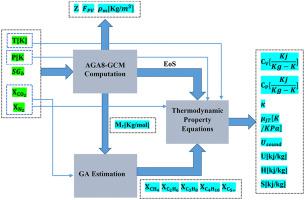Flow Measurement and Instrumentation ( IF 2.3 ) Pub Date : 2020-12-30 , DOI: 10.1016/j.flowmeasinst.2020.101879 Shaghayegh Nazari , Fatemeh Bashipour

|
Precise computation of thermodynamic properties of natural gas requires applying an accurate Equation of State (EOS) along with component analysis of natural gas. This procedure is a time consuming process which demands expensive apparatuses. In this study, a rigorous model by firstly applying a gross standard EOS called AGA8-GCM is used to predict compressibility factor (Z) and density (ρ). The required input data for this model are operating temperature and pressure, specific gravity at reference conditions, and merely the amount of nitrogen and carbon dioxide in the natural gas. Then, Genetic Algorithm (GA) is employed to estimate component analysis to increase the accuracy of following calculations. Finally, the thermodynamic properties equations, in which partial derivatives were obtained by AGA8-GCM equation is used to calculate other thermodynamic properties: the speed of sound (), heat capacity at constant volume and pressure (, ), Joule-Thomson coefficient (), isentropic exponent (κ), internal energy (U), enthalpy (H), and entropy (S). In order to validate the model, the calculated data were compared to experimental ones collected from literature by the Average Absolute Deviation percentage (AAD%). The AAD% amounts for , , , , , , , , and were obtained 0.025%, 0.063%, 0.51%, 0.94%, 1.22%, 3.06%, 0.064%, 0.62% and 2.46%, respectively. The pure methane data is utilized for , , , and evaluation as for the lack of empirical data. Furthermore, comparing calculated data with that of AGA8-DCM (Detail Characterization Method), requiring detailed composition of natural gas, shows reliability of this model in the custody transfer region. Investigating the model uncertainty showed a figure of about ±0.1% for both the compressibility factor and density. However, as for the other thermodynamic properties, this figure was usually higher (<0.8%).
中文翻译:

无需应用全部成分分析即可计算天然气热力学性质的严格模型
天然气热力学性质的精确计算需要应用准确的状态方程(EOS)以及天然气的成分分析。该过程是耗时的过程,需要昂贵的设备。在这项研究中,首先通过应用称为AGA8-GCM的总标准EOS的严格模型来预测压缩系数(Z)和密度(ρ)。该模型所需的输入数据是工作温度和压力,参考条件下的比重,以及天然气中氮和二氧化碳的量。然后,采用遗传算法(GA)进行成分分析估计,以提高后续计算的准确性。最后,通过AGA8-GCM方程获得偏导数的热力学性质方程用于计算其他热力学性质:声速(),在恒定体积和压力下的热容量(, ),焦耳-汤姆森系数(),等熵指数(κ),内能(U),焓(H)和熵(S)。为了验证模型,将计算的数据与通过平均绝对偏差百分比(AAD%)从文献收集的实验数据进行比较。的AAD%金额, , , , , , , 和 分别获得0.025%,0.063%,0.51%,0.94%,1.22%,3.06%,0.064%,0.62%和2.46%。纯甲烷数据用于, , 和 对于缺乏经验数据的评估。此外,将计算的数据与需要详细组成天然气的AGA8-DCM(详细表征方法)的数据进行比较,表明该模型在贸易交接地区的可靠性。对模型不确定性的调查显示,可压缩系数和密度均约为±0.1%。但是,至于其他热力学性质,该数字通常更高(<0.8%)。











































 京公网安备 11010802027423号
京公网安备 11010802027423号